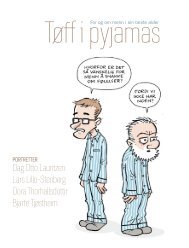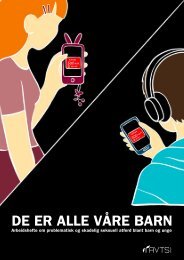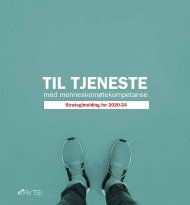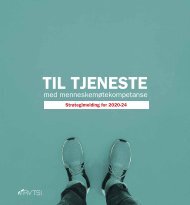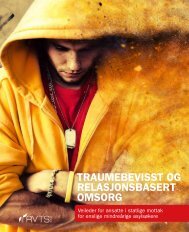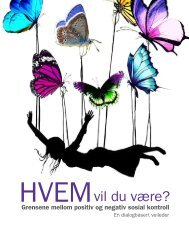Tree Of Life Inspiration Booklet
You also want an ePaper? Increase the reach of your titles
YUMPU automatically turns print PDFs into web optimized ePapers that Google loves.
The <strong>Tree</strong> of <strong>Life</strong><br />
<strong>Inspiration</strong> booklet<br />
Gunnar Eide og Torunn Fladstad<br />
ABUP/RVTS South<br />
Norway
Photo: Hilde Kjærstad<br />
Torunn Fladstad • Senior advisor RVTS South • torunn.fladstad@rvtssor.no • phone: + 47 468 93 104<br />
Gunnar Eide • Senior advisor RVTS South • gunnar.eide@rvtssor.no • phone: + 47 920 60 624<br />
Cover photo: Tone Weire Jørgensen • Backside photo: Torunn Fladstad • Design: Therese Skauge Klokset/RVTS South<br />
Translation to english by: Gjertine Myklebust
This booklet is part of a training package for<br />
conversation leaders in the <strong>Tree</strong> of <strong>Life</strong> Workshop<br />
with children and adolescents of refugee<br />
background, usually unaccompanied minors. The<br />
training includes one day of theory and individual<br />
exercises and two days of group exercises under<br />
supervision. This booklet is intended to serve<br />
as support and inspiration after the training is<br />
completed, and is developed in a collaboration<br />
between RVTS South, Regional trauma center,<br />
Norway (rvtssor.no) and Department of Child and<br />
Adolesence Mental Health (abup.no).<br />
As a conversation leader, it is important to<br />
remember that the <strong>Tree</strong> of <strong>Life</strong> process is one<br />
of dialogue and reflection. In this inspiration<br />
booklet, we will give examples of questions that<br />
can be a good starting point for further reflections<br />
and conversations with the participants.
4<br />
What is the <strong>Tree</strong> of <strong>Life</strong>?<br />
The <strong>Tree</strong> of <strong>Life</strong> is part of a process of strengthening one’s<br />
identity where the tree is a metaphor for life itself. The roots<br />
of the tree represent one’s background: where one comes<br />
from, family, good memories from childhood, important values<br />
and good experiences. The earth represents life here and<br />
now, well-being and happiness in everyday life. The trunk of<br />
the tree represents one’s personality; that which you are good<br />
at, such as dancing, singing, fixing cars and more personal<br />
qualities such as being caring, responsible etc. The branches<br />
represent hopes and wishes for the future. The leaves on the<br />
tree represent important people in one’s life, and the fruits<br />
represent what meaning they have in the individual’s life and<br />
what they learned from them.<br />
The process of drawing and writing on the tree is divided into<br />
two: First, one concentrates on all that is good to remember,<br />
that which makes one proud and happy. Each person presents<br />
their tree to the others. The others then give feedback on what<br />
that person means to them and what strengths they see in<br />
them. Secondly, the focus is on storms in one’s life, i.e. the<br />
difficulties the participants have encountered in life. One does<br />
not go into their storms in detail, but discusses how different<br />
storms affect emotions, thoughts and actions. The main focus<br />
is on what the participants did to get through the storms and<br />
what is good to remember to do when one encounters storms<br />
in life. The group becomes an arena for reflection and coping on<br />
mastering and opportunities, even though a person has been<br />
exposed to painful situations in life.<br />
The <strong>Tree</strong> of <strong>Life</strong> is derived from Narrative<br />
practice. The method was developed in<br />
South Africa and Zimbabwe in working with<br />
children who had lost parents in war or from<br />
HIV/Aids.<br />
This was a collaboration between the Dulwich Center in<br />
Australia and the REPSSI organization in Zimbabwe*. The<br />
purpose of the <strong>Tree</strong> of <strong>Life</strong> is to strengthen the identity of the<br />
participants and create a context in life. The dominant painful<br />
story often prevent the memory or awareness of all of the<br />
important and good things the person may have experienced<br />
in life. Starting from the good, the person one wants to be and<br />
the hopes, dreams and values one has for their life, creates a<br />
safe platform for conversations about the difficulties and pain<br />
one has experienced.<br />
The <strong>Tree</strong> of <strong>Life</strong> can be used both in groups and with<br />
individuals. It is important that<br />
the process is followed by<br />
close caregivers,teachers,<br />
social workers and so on, so<br />
that conversations about life<br />
can be continued in everyday life<br />
in an expanded understanding of<br />
who the young person really is and<br />
wants to be.<br />
Start-up at the <strong>Tree</strong> of <strong>Life</strong><br />
workshop<br />
After a presentation of the participants (write<br />
everyone’s name and where they come from on a<br />
board or flipchart), it’s a good idea to present why<br />
we are here and what the day will contain. Give a<br />
brief introduction to the different parts of the tree<br />
so that the participants understand the metaphor<br />
of the <strong>Tree</strong> of <strong>Life</strong>.<br />
Feel free to say something about the<br />
following:<br />
Why are we doing this? What you all have<br />
in common is that you have experienced<br />
to flee from your homeland and come to<br />
a completely new and foreign country. That creates some very<br />
special challenges and your bodies, emotions, thoughts and<br />
actions are all affected by this. It is important to be aware of<br />
how you can take care of yourself in this situation, how you<br />
can support each other and how adults around you can best<br />
contribute.<br />
To conversation leaders: Draw on the board/flipchart two<br />
circles (two suns). In one you write physical health, in the other<br />
mental health. Invite the participants to discuss the following:<br />
How can we take care of our body/physical health?<br />
(Write down what the participants suggest like rays on the sun.)<br />
Continue with:<br />
What can we do when we have painful feelings or thoughts?<br />
(Write down what the participants suggest as rays on the sun<br />
about mental health.)<br />
And follow up with reflection on:<br />
Does physical and mental health interrelate?<br />
*Dulwich Centre Institute of Community Pravtice, www.dulwichhcentre.com.au<br />
Repssi: www.repssi.org/psychosocial-support
Hopes and dreams<br />
for the future<br />
Important people in your<br />
life and what you have<br />
received from them<br />
Talents,<br />
skills and<br />
characteristics<br />
The <strong>Tree</strong> of <strong>Life</strong><br />
What makes you happy<br />
in everyday life<br />
Where you are from/<br />
your roots
6<br />
One sum up can be:<br />
All of us have physical and mental health and all of us may be<br />
at risk of our mental health being exposed to challenges. One<br />
challenge may be if you are in a new place without your family.<br />
At one time, you might have been surrounded by parents,<br />
relatives, friends, and lived in a familiar society and culture.<br />
Who is around you today? Who knows you? Who has thoughts,<br />
wishes and hopes for your future? And if you do not have<br />
anyone, what can happen then? How may you react?<br />
If there is little response from the participants, you could say<br />
that others who have participated in the <strong>Tree</strong> of <strong>Life</strong> have<br />
expressed that they could become sad, depressed, experience<br />
feelings of hopelessness and loss, being lonely, experiencing<br />
panic, having painful feelings, reacting with anger. Here you<br />
can draw up two circles again. One is about the people they<br />
had around them in their home country, the other about the<br />
people they have around them today.<br />
Begin with what has been mentioned by the participants and<br />
normalize their reactions. For example, in the following way:<br />
What you are describing are completely normal reactions when<br />
you are alone, far away from your family, your relatives, your<br />
culture... When you experience such challenges in life, it’s<br />
important to share your experiences and find new people you<br />
trust. Remember that you already have done, and continue to<br />
do a lot, to cope with difficult situations.<br />
At the same time, it is important that you know that it is okay if<br />
you have secrets or there are things you do not want to share<br />
about your life. You decide what you want to share; it is your<br />
<strong>Tree</strong> of <strong>Life</strong>.<br />
The aim is for you to feel stronger after these two days with the<br />
<strong>Tree</strong> of <strong>Life</strong>. It requires a lot of strength to be in the situation you<br />
are in now. We want to support you, and we want to encourage<br />
you to support each other.<br />
We use the tree as a metaphor for, or image of, our life. What do<br />
you know about trees? For example, trees consist of different<br />
parts - roots, trunk, branches, leaves, fruits. <strong>Tree</strong>s change with<br />
the seasons, they grow in woods or stand alone, they grow big<br />
and tall or are small and low, and they stand both in storms and<br />
sunshine. We shall imagine that parts of our lives are like parts<br />
of the tree and make our own personal tree.<br />
If you are still unsure of participation if the <strong>Tree</strong> of <strong>Life</strong> iprocess,<br />
then we can tell you a little about what other young people have<br />
said after making their tree:<br />
- We have learned a lot about each other.<br />
- Never give up, there’s always hope.<br />
- No one has asked us about our background before!<br />
- It’s good to know what my friends here think about me.<br />
It helped a lot.<br />
- We can use these experiences later in our everyday lives.<br />
The <strong>Tree</strong> of life is about telling stories about yourself. If you<br />
were to present yourself today, you may say that you are a<br />
refugee from Afghanistan (say the names of all the countries<br />
the participants come from) and that you have experienced a<br />
lot of pain. Right now, that is probably what dominates your<br />
story. But we think you are much more than this and the <strong>Tree</strong><br />
of <strong>Life</strong> is about telling a whole story about yourself. A story not<br />
just about what’s hard, but also about good memories, your<br />
skills, qualities, everything you are good at and your hopes and<br />
wishes for the future.<br />
Working on the tree<br />
So far, all the participants have been involved as a group. Now<br />
the participants will start creating their <strong>Tree</strong> of <strong>Life</strong> and also<br />
working individually, with support from the conversation leaders<br />
and as a group.<br />
We will now start working on the tree. Remember that today’s<br />
focus is on good memories, that which is good and important<br />
to remember, and all the wealth you have in your own culture<br />
and history. When you have experienced a lot of pain, such as<br />
having to flee your homeland as a result of war and conflict<br />
and arrival to a new and foreign country, it is normal to want to<br />
forget. Today we will try to remember, but concentrate on what<br />
is good to remember.<br />
Photo: Hilde Kjærstad
Photo: Gunnar Eide<br />
7
Photo: Hilde Kjærstad<br />
8<br />
The tree<br />
The ground - What you like about your everyday life<br />
We start with life here and now because we have experienced<br />
that it makes it easier to go from here to the roots, instead of<br />
starting with the roots.<br />
We will start with life today and what you think is good about<br />
that. You can write keywords on the line above the roots.<br />
- What is good in your life now? Where do you live? (This can<br />
be about safety, possibilities, laws and regulations, rights,<br />
school, caregivers who help and support, peace ...)<br />
- What brings you joy in everyday life? What do you like to<br />
do? (This can be music, exercise, sports, school, football<br />
and activities, Play Station ...)<br />
- Who do you like to spend time with? And what do you do<br />
together?<br />
NB! REMEMBER! Help the participants to create short stories<br />
about what is good in life.<br />
End this sequence with asking the participants to tell some of<br />
the things they have written. You could write it on a blackboard<br />
/flipchart. As a transition to the next part of the tree, the<br />
roots, ask if any of the participants have any music from their<br />
home country on their phone. Ask them to play it, and explain<br />
afterwards that this is an example of things we bring from<br />
our own culture, our own roots. Ask them to mention other<br />
examples of things we can bring with us from our homeland,<br />
such as national clothes, cooking, traditions etc.<br />
The roots - Where you come from<br />
The roots are a metaphor for where you come from. We highlight<br />
good memories and stories that you migth carry with you in<br />
your everyday life!<br />
Examples of questions and topics can be:<br />
- Where did you live? Country? City? Countryside?<br />
- Who did you live together with?<br />
- What did your parents do?<br />
- Culture? Ethnic group?<br />
- Family / family history? What does your surname mean?<br />
First name? Songs? Dance?<br />
- What do you value and appreciate from your home country?<br />
Remember, it’s about getting the<br />
participants to tell short stories - and your<br />
curiosity and interest will help the process.<br />
If painful or sad memories surface, it is wise to help the<br />
participant to change their focus to something else. For<br />
example, you could say that having thoughts can be compared<br />
to a train travelling with many wagons. If something in particular<br />
has happened the train may stop, and maybe one of the<br />
wagons that has stopped is loaded with painful memories. If<br />
this happens it is important to get the train to drive on and to<br />
bring forward new wagons with different cargo. For example,<br />
ask the participants to share something about what it is that<br />
is painful to think about. Recognise it as something normal,<br />
confirm that it hurts, but help the participant to move on.<br />
For example:<br />
Participant: ”I was thinking about my mum. I don’t know where<br />
she is. I miss her and it hurts to think about. ”<br />
Conversation leader: ”I understand, it must be painful to think<br />
about her. Can you tell me something about your mum? What<br />
kind of mum was she? What kind of food did she make, etc.”<br />
End this sequence with the participants saying something in<br />
the group about what they have written, this time about their<br />
roots. You could write it on a blackboard/flipchart. Working on<br />
the rest of the tree, the participants work on their own tree<br />
first, before they present their tree to the rest of the group.<br />
The trunk of the tree – Talents, Skills and<br />
Characteristics<br />
Here it is about both what the participants are good at, for<br />
example dancing, singing, fixing cars, etc. and their personal<br />
qualities, such as patience, responsibility, thoughtfulness, etc.<br />
In the introduction you can say that it is not so simple and<br />
common to say good things about ourselves. The participants<br />
will most likely need help to get started with this process, for<br />
example, you could start with one of the following questions:<br />
- What kind of person would you like to be? What is a good<br />
human being?<br />
- What are you good at? And what qualities characterise you<br />
as a person?<br />
- How will others describe you?
- What would your mother, your father, or your best friend say<br />
about you?<br />
- And what do you like to hear others tell about you?<br />
This can be something the person does every day without<br />
considering that these are good qualities that characterise him<br />
or her as a person. Help the participants to recognise how<br />
they may for example, take care of others, give compliments,<br />
enjoy humour and make others laugh, be a good friend, calm<br />
conflicts and take care of themselves.<br />
The branches - Hopes and wishes for the future<br />
The branches on the tree stretch out from the trunk and<br />
represent hopes and wishes for the future. Help the participants<br />
to formulate at least one wish they have for themselves, one<br />
for their family and one for their country.<br />
Examples of questions and topics related to the branches<br />
might be:<br />
- Do you have a goal or something you want to work toward?<br />
What do you want to happen in the future? Dreams? Hopes?<br />
- What is the first step towards achieving your goal?<br />
- How long have you had these desires and how have you<br />
managed to keep them alive?<br />
- Do you have an example of something you want for others?<br />
Your homeland, family, friends ... and for the world?<br />
- Problems can sometimes overshadow hopes and wishes,<br />
What can then be helpful? Do you have a backup plan or can<br />
you imagine other possibilities if your goal is hard to achieve?<br />
Here is an example from a group that could also be<br />
communicated to the participants:<br />
During the work with hopes and wishes for the future, one of<br />
the young people said that he had no hope, that everything<br />
was just sad and difficult. One of the other in the group said<br />
that one should keep in mind that when it is overcast, the sun<br />
is still shining over the clouds. He said that it is important to<br />
think about this when things become difficult. He called<br />
this ”Thought Power”<br />
The leaves and fruits - Important people in your life<br />
and what they gave to you<br />
The leaves and fruits on the trees are connected. On the leaves<br />
the participants write important people in their lives. This can<br />
be important people from their homeland, people they have<br />
met during their journey or people they know today. It may also<br />
be people who are no longer alive but who live in the heart of<br />
the person. The fruits are connected to the leaves, and signify<br />
what the participants have been given or have learned from<br />
these important people.<br />
Examples of questions and topics related to the leaves can be:<br />
- Can you share stories about people that have been and still<br />
are important to you? This can also be people that may not<br />
be alive, but that live in your heart.<br />
- Why are these people important to you?<br />
- What is special about him/her?<br />
- Can you remember anything that you did together that meant<br />
a lot to you?<br />
- Would this person appreciate you remembering him/her in<br />
this way?<br />
- Is this person/these people someone who has/would have<br />
had great hopes for you today?<br />
- Do you know that you are important leaves in other people’s<br />
lives?<br />
Examples of questions and topics related to the fruits can be:<br />
- What have these important people given you that you<br />
especially appreciate today? What have you learned from<br />
them? Is there anything very special that you appreciate?<br />
9<br />
”After dark comes the light.”<br />
Photo: Unaccompanied minor<br />
asylum-seekers in Lillesand/<br />
UngeBlikk.
A forest of trees - Presentation of the participants’ trees<br />
Before the presentation of the participant´s trees, all trees are<br />
stiched to the wall. This create a beautiful forest of trees. A<br />
short reflection about the trees and what they have in common<br />
is recommended.<br />
Afterwards:<br />
Each participant presents his or her tree. Help the participants<br />
to describe their tree: Ask them to share one thing from the<br />
roots, one from life here and now, focus on hopes and wishes,<br />
leaves and fruits. Finish with the trunk, qualities and abilities.<br />
Just before you move on to the trunk say out loud to the<br />
participants that they are going to give each other gifts in the<br />
form of writing ”positive notes” to each other. On these notes,<br />
they describe what the person presenting means to them, and<br />
what qualities and abilities they see in the person.<br />
10<br />
The participants come forward one by one and stick the postit<br />
notes on the tree of the presenter. It is important that the<br />
feedback is rooted in specific events and that questions are<br />
asked that explore deeper.<br />
Photo: Gry Tangstad<br />
This may, for example, be about mum and dad, about their<br />
kindness and love, what the person was taught about history<br />
and culture, friends who helped in difficult situations, a loving<br />
and caring grandmother etc. It is important to raise awareness<br />
amongst the participants that it is good to have people in their<br />
heart that they know are thinking of them and want them to live<br />
a good life. Keep in mind that this is a sensitive topic that may<br />
also be associated with loss and sadness. It will be important<br />
both to listen to these feelings and to confirm them, while<br />
trying to talk about the meaning of this person in their life.<br />
In narrative practice, we call this double listening. On the one<br />
hand, we listen to the expression of pain in the person’s story.<br />
On the other hand, we listen to positive response, meaning and<br />
initiative that focuses on resources and is an expression of<br />
power and support in life here and now. (Ref: Maps of narrative<br />
Practice, 2017, Michael White).<br />
Sometimes we encourage participants to, for example, write<br />
some words to one of the persons who have meant/means<br />
a lot to them. The purpose here is to put into words the<br />
meaning of the relationship and to honour the person, although<br />
unfortunately it will not always be possible to actually convey<br />
these words.<br />
Example:<br />
You said he is good at helping others. Has he helped you with<br />
anything? Can you tell about one time he helped you?<br />
It can sometimes be difficult for participants to fully express<br />
the meaning the person has for them. In that case we help the<br />
participant further in the description.<br />
The presentation and feedback is concluded by asking each<br />
individual:<br />
- How was it to receive all the nice comments about you?<br />
- What would your mum/dad think if they heard all the nice<br />
comments about you?<br />
Comment and summarise the feedback each participant gave<br />
to each other and the meaning that they each hold for one<br />
another.<br />
After the participants have presented their tree and have<br />
received feedback, it may be important to say something about<br />
how to treasure all the positive words that they have heard<br />
about themselves. For example in the following way:<br />
The brain can be compared with a computer. You can store both<br />
what is good and what is sad or painful. Sometimes it would<br />
be easier if it were possible to press ”delete” and remove all<br />
the bad things. That is dificult! However, maybe you can save<br />
all the good feedback you have heard and received today in a<br />
new file. When life is difficult, you might be able to retrieve the
good file? But remember: there is a time for everything - both to<br />
cry, smile and dance. When you go through life and notice that<br />
heavy thoughts and feelings appear, it’s not always a good idea<br />
to try to forget and it might well be very difficult. It might also<br />
be important to seek comfort, understanding and support from<br />
another person, in nature, in God or other things in life that you<br />
have experienced can help you.<br />
Storms of life<br />
This is both an important but also challenging part of the <strong>Tree</strong><br />
of <strong>Life</strong>. It is important to avoid getting into details of what the<br />
participants have experienced, focus rather on how they got<br />
through the storms. It is important to have a clear leadership<br />
that brings the group further if one of the participants begins to<br />
tell details from his or her ”storm”.<br />
When we talk about storms in life, we often use metaphors<br />
including trees and natural forces. Try to get the participants<br />
to reflect on, for example, that trees may be beautiful, they<br />
may have deep roots, a strong trunk, and branches extending<br />
outwards, full of leaves and fruits. However, are the trees<br />
always left standing in peace? What dangers can trees be<br />
exposed to? What can storms, cold, rain, drought, fire, lightning<br />
and such things lead to?<br />
The metaphor of the storms is then lifted into the lives of the<br />
participants. For example, in the following way:<br />
Just like trees, people are exposed to storms and stresses<br />
in their lives. No one can go through life without storms, but<br />
some people experience stronger storms than others. All of<br />
you sitting here have been exposed to some of the most fierce<br />
storms people may be exposed to. We know that many of you<br />
have experienced, seen and heard painful things. We will not<br />
talk about the details of what you have experienced, but about<br />
how the storms affected you and what it looks like now. Many<br />
previous participants in the <strong>Tree</strong> of <strong>Life</strong> have told us that they<br />
have trouble sleeping, that it may be difficult to concentrate at<br />
school, that they have pain in the stomach or head, that they<br />
can often become both angry and sad.<br />
Specifically, we are interested in the following:<br />
- What storms have you experienced?<br />
- Who / what helped you in each storm?<br />
- What initiatives did you take?<br />
- What skills did you have to use?<br />
- What was especially helpful and why?<br />
And more general ”life wisdom” like:<br />
- What can you do when you encounter a storm in your life?<br />
- What is good to remember when in a storm?<br />
- What storms are you in now? What can be future storms?<br />
- From whom and where can you get help?<br />
Write up what the participants say. For example, war, fleeing<br />
from their home, hunger/thirst, leaving and missing their<br />
family, losing someone they love, being alone, not knowing<br />
where their family is, abuse, violence, etc.) Ask participants<br />
about how strong these storms were.<br />
If 0 is weak and 10 is max, how will you place the storms you<br />
have been in? How strong were your storms?<br />
We know that such storms in life have a negative effect on<br />
both feelings, thoughts and actions. What feelings dominated<br />
in your storms?<br />
It is important to communicate that both<br />
sadness, fear and anger can be strong, but<br />
completely normal emotions in such a<br />
situation.<br />
Photo : Martha Moen<br />
11
12<br />
Photo: Rolf Rohde<br />
”Never give up.<br />
There is always a hope.”<br />
Participant
What thoughts do you have when you stand in such a storm?<br />
Normalize what comes up, for example, thinking that there is<br />
no hope, that one can die, never reaching the goal, thinking why<br />
is this happening to me, that it is unfair and so on.<br />
Say something about the fact that when bad thoughts and<br />
emotions dominate, you may want to do something that is not<br />
good, you might want to give up. You may ask questions such<br />
as: What is the point of life? What is going to happen? You<br />
may feel uncertain and be both afraid and sad. As a result,<br />
strong feelings and painful thoughts can make us want to do<br />
something that is not good - it is both normal and natural.<br />
Then go from what is painful to what is possible:<br />
But you never gave up. You managed what is almost impossible!<br />
After you fled your homeland and completed the long journey,<br />
you arrived here. Many of you are now in school and have plans<br />
for the future. What was it that helped you?<br />
How did you manage to get through the storms?<br />
(Write down what the participants say on a board/flipchart.)<br />
Here is an example of what a young person, 14 years old,<br />
answered:<br />
”I think I’m a tree with a weak root. It is possible that it can<br />
be broken. Right now I feel very weak. If I get to stay in Norway<br />
I think I can manage... I had a lot of troubles when I was in<br />
Afghanistan. It was a tough situation. And a dangerous journey.<br />
I was often sure I would die. It did not happen. I survived. But<br />
it was very tough and dangerous.”<br />
Answer: ”You have been in a heavy storm. You have arrived<br />
here. And you’ve managed. - Is there anyone else who has the<br />
same feeling, that your roots have become weak? What must<br />
happen for the roots to grow strong again? ”<br />
Here is an example of a concrete and visual way of talking<br />
about this:<br />
Lay out a rope on the floor, approximately 6 meters long. Explain<br />
that one end of the rope marks the storm at its strongest,<br />
the other end marks the storm at its weakest. Ask the<br />
participants to first stand where the storm was strongest and<br />
then stand where they feel the strength of the storm is today.<br />
The experience with this exercise shows that everyone marks<br />
a change over time. Then ask the participants the following<br />
questions:<br />
- What did you do to get there? What helped you? What did<br />
others do for you?<br />
Then move on to life today. Ask if there are storms that the<br />
participants are experiencing now and storms they think may<br />
come in the future. (Write down what the participants say on<br />
a board/flipchart.) Try to get a conversation going about wise<br />
things they have learned to do when it is stormy.<br />
- How can you hold on to the hopes and goals you have for life<br />
even if you’re in a storm? Maybe hope is something that must<br />
be found and won again, time after time after time, after each<br />
storm? What do you think about that?<br />
After the conversation about the storms, the adults who have<br />
participated in the workshop are invited to say something about<br />
the impression the young people have made on them and what<br />
they will take with them from what they have heard. Ask about<br />
how their own lives have been enriched by participating in this<br />
and if it has changed anything in their thoughts and perceptions<br />
of the young people, their qualities and abilities. Ask also what<br />
they think the young people’s own parents and family would<br />
think if they had been present. Feel free to use metaphors from<br />
the tree. For example, ask if the young person is a fruit in their<br />
lives! And finally ask them to say what they have seen among<br />
the young people that makes them think they’ll get through<br />
their storms.<br />
Ending<br />
We stand in a circle and hold each other’s hands. Feel free<br />
to say something about the work with the trees and how the<br />
participants can take these experiences with them in their lives:<br />
- Take care of the beautiful trees. Nurture them, let them grow<br />
inside you and become strong so that you can stand in strong<br />
winds and storms, so that you can withstand cold without<br />
getting cold in your heart. Take care of the deep roots, although<br />
they are far away; it is your loving memories that keep them<br />
alive. You are on your way to strong, beautiful trees. To grow<br />
you need nutrition; take good care of yourself and each other.<br />
- We hold hands together because no one can cope alone. We<br />
depend on each other and need each other both when life is<br />
good and when life is difficult. Now we shall send a handshake<br />
around the circle. This symbolizes the good wishes we have for<br />
each and every one of you. Remember to take care of yourself<br />
and each other. Remember to take care of your hopes and<br />
wishes for life.<br />
13
-THANK YOU for all the experiences and stories you have shared<br />
with us and with each other. Meeting you and sharing these<br />
days with you helps to give faith in human kind.<br />
Certificate<br />
After this, a certificate can be given to the participants. This<br />
may take time to write, so it is important to agree beforehand<br />
who will write the summary for each participant.<br />
The certificate should be a short version confirming some<br />
of the important things the participant has communicated,<br />
and what others have said about them. There should be no<br />
interpretation, but as much concrete description as possible.<br />
Write one or two things from the roots, the same from life<br />
here and now, something about skills and abilities, one or two<br />
important people in the person’s life and the most important<br />
thing about their hopes and dreams.<br />
However, the tree of life can also be carried out over many<br />
shorter sessions, for example in conversation groups, meeting<br />
once a week. Then you can work with the different parts of the<br />
tree over time.<br />
The method is further suitable for a family context, especially<br />
in refugee families, where children and young people together<br />
with their parents can confirm good experiences, culture and<br />
together look at hopes and wishes for the future.<br />
We wish you good luck in the work with the <strong>Tree</strong> of <strong>Life</strong> and<br />
would like to hear from you about your experiences, and<br />
any suggestions for changes that promote the process and<br />
participation!<br />
14<br />
Here is an example:<br />
Ibrahim is from Afghanistan and has many memories from his<br />
childhood. He loved celebrations and was especially fond of his<br />
grandfather, who taught him a lot about respect. In Norway, he<br />
enjoys life and has got new friends and brothers. He loves music,<br />
and songs from his home country are especially important. His<br />
friends say that he is a happy boy who brings a good mood in<br />
the home. He is caring and takes a lot of responsibility. He<br />
highlights his mother as one of the most important people in<br />
his life. She has given him a lot of love and taught him how<br />
to cook. Ibrahim dreams of becoming a car mechanic. He is<br />
working hard at school to achieve this goal. He also dreams of<br />
peace in Afghanistan, meeting his family again and being able<br />
to help other people.<br />
The actual completion and handing out the certificates can be<br />
organized as a separate gathering. For example, as a party, or<br />
a celebration where other people important to the participants<br />
can be invited. It may also be an idea to laminate the tree,<br />
preferably with the positive notes on the back. This will make it<br />
easier to take care of the tree and the positive feedback they<br />
have received. The tree can also be used as a starting point for<br />
telling other important people in the participant’s lives about<br />
themselves.<br />
Organization and opportunities<br />
This booklet has been based on a process that takes place<br />
over two days. It is important to include other involved sectors<br />
such as school, housing and health care. In our Community,<br />
Kristiansand in Norway, the <strong>Tree</strong> of <strong>Life</strong> has been included in<br />
the school plans, which simplifies practical implementation and<br />
allows as many as possible unaccompanied minors to attend.<br />
References<br />
1. Denborough, David, 2008, Collective Narrative Practice.<br />
Dulwich Center Publications.<br />
2. http://www.dulwichcentre.com.au/tree-of-life.html<br />
3. Denborough, David, 2008, Collective Narrative Practice:<br />
Responding to individuals, groups and communities who have<br />
experienced trauma. Adelaide: Dulwich Center Publications.<br />
4. White, Michael, Maps of narrative Practice, 2007.
”Be strong, be purposeful and<br />
always show love to those you<br />
meet. These words gave me<br />
strength on the long, difficult<br />
journey. ”<br />
Participant<br />
15<br />
Photo: Martha Moen
RVTS South. Regional trauma center, Norway<br />
www.rvtssor.no<br />
Department of Child and Adolesence Mental Health,<br />
Sorlandet hospital<br />
www.abup.no






